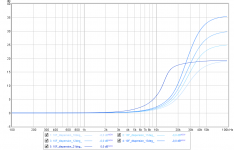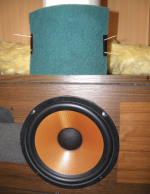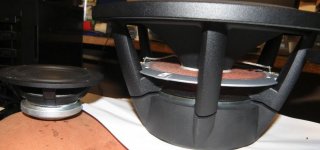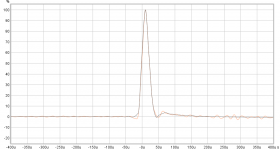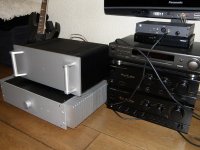Ha ha your points is absolute right, but what if i say i had been dancing around over this simple but logic steered correction because it sounds so right and the proof for this dumb ugly looking exercise speaker is that it now all over room sounds so close to sound stage in Senheiser HD650 cans that one think one are dreaming  but of course i need to get microphone onto this aspect later.
but of course i need to get microphone onto this aspect later.
In past also tried some simple lifts up high to compensate for beaming and loss of power response up in high frq area but it never sounded right, but using dispersion loss for a 68mm diameter driver from a spreadsheet then two of them sounds as heaven and its the 12º plus 13º seen below that rocks where 10º/11º/21º just sound more or less interesting, for more tests still need to make corrections for 14º/15º/16º/17º/18º/19º/20º.
Mayby this correction will only work when using one 68mm tweeter, but i will be curious how it sounds on yours 25 times 68mm tweeters : )
By the way 10F got some clothes to warm it and also got a new interesting woofer to pair with 10F together a enclosure with 3 inch radius round overs all over, driver is WO24P-8 from SATORI series and its so nice looking behind that its a shame put a box around it .
.
In past also tried some simple lifts up high to compensate for beaming and loss of power response up in high frq area but it never sounded right, but using dispersion loss for a 68mm diameter driver from a spreadsheet then two of them sounds as heaven and its the 12º plus 13º seen below that rocks where 10º/11º/21º just sound more or less interesting, for more tests still need to make corrections for 14º/15º/16º/17º/18º/19º/20º.
Mayby this correction will only work when using one 68mm tweeter, but i will be curious how it sounds on yours 25 times 68mm tweeters : )
By the way 10F got some clothes to warm it and also got a new interesting woofer to pair with 10F together a enclosure with 3 inch radius round overs all over, driver is WO24P-8 from SATORI series and its so nice looking behind that its a shame put a box around it
Attachments
Last edited:
Is this the bat ears EQ? I am thinking of making a budget 2-way with this tweeter. Super high end and 94dB with 100W capability.
Peerless DA25BG08-06 1" Aluminum Dome Tweeter 6 Ohm
I think with dual Beta 8cx a system that is 94dB efficient after baffle step loss is possible. Anyhow I have a simple crossover designed already.
Peerless DA25BG08-06 1" Aluminum Dome Tweeter 6 Ohm
I think with dual Beta 8cx a system that is 94dB efficient after baffle step loss is possible. Anyhow I have a simple crossover designed already.
Ha ha your points is absolute right, but what if i say i had been dancing around over this simple but logic steered correction because it sounds so right and the proof for this dumb ugly looking exercise speaker is that it now all over room sounds so close to sound stage in Senheiser HD650 cans that one think one are dreamingbut of course i need to get microphone onto this aspect later.
In past also tried some simple lifts up high to compensate for beaming and loss of power response up in high frq area but it never sounded right, but using dispersion loss for a 68mm diameter driver from a spreadsheet then two of them sounds as heaven and its the 12º plus 13º seen below that rocks where 10º/11º/21º just sound more or less interesting, for more tests still need to make corrections for 14º/15º/16º/17º/18º/19º/20º.
Mayby this correction will only work when using one 68mm tweeter, but i will be curious how it sounds on yours 25 times 68mm tweeters : )
By the way 10F got some clothes to warm it and also got a new interesting woofer to pair with 10F together a enclosure with 3 inch radius round overs all over, driver is WO24P-8 from SATORI series and its so nice looking behind that its a shame put a box around it.
I'd love to see measurements, as technically, my arrays are EQ-ed at about a 15 degree angle already. Not on axis... There is plenty of boost up top compared to below 16 kHz, but not as much as you show.
By the way, measurements at 2.5 m would work best (only showing the top end). A waterfall at 1 ms window length would help too.
From measuring my single 10F ambient channels they seem to do 18K+ much more easily.
I'm flat out till 18 kHz, above that it will drop pretty fast. I didn't like the sound when I tried to EQ them above it, believe me I tried.
It might be that I am sensitive to hot top ends, I never particularly enjoyed that. I am aware most people actually seem to prefer it, as could be seen in the full range tests X ran a few years ago. I never warmed up to that sound. It's just not how I experience sounds in the real world around us.
When visiting a friend with decent Studio speakers with a wave guided dome I was shocked at the high frequency levels, it was like cutting trough a layer of mist for me. (as if I could actually see it) Took me a while to adjust, but I never warmed up to that type of sound. Lots of high end speakers seem to have it as a feature.
For me, personally, the magic is in the mid-range...
Last edited:
Year we need measurements and maybe room recordings with and without the filter to get more grab on what my ear sense at the moment, later on tomorrow i could do that.
You right from X's test there was some nasty break up schemes from some drivers up high that would get even worse with this filter to correct for power response, but maybe what saves me here is on axis i have 10F corrected to a 25kHz controlled BW2 with 192kHz DSP engine power, so the hot beam from 10F at least on axis should not be a bell ringer as seen on below overlaid synthetic target verse acoustic IR.
Don't think i have it as hot as you sensed on the studio visit in i carefull have compared to HD650 and also what memory say about top end for other speakers for example Beolap 90, so far its all subjective but think it makes sense if one can find a controlled boost pattern that suits the beaming scheme 3500Hz and up for a 68mm diameter and listen off axis then room sound will be more natural in that frq response at the ear is probably what matter most, and when using the 12º and 13º boost schemes sound starts be the same all over the room even in corners, that said VHF area are not so natural a sound as telephone band is but what ever tweeter can real world do that.
You right from X's test there was some nasty break up schemes from some drivers up high that would get even worse with this filter to correct for power response, but maybe what saves me here is on axis i have 10F corrected to a 25kHz controlled BW2 with 192kHz DSP engine power, so the hot beam from 10F at least on axis should not be a bell ringer as seen on below overlaid synthetic target verse acoustic IR.
Don't think i have it as hot as you sensed on the studio visit in i carefull have compared to HD650 and also what memory say about top end for other speakers for example Beolap 90, so far its all subjective but think it makes sense if one can find a controlled boost pattern that suits the beaming scheme 3500Hz and up for a 68mm diameter and listen off axis then room sound will be more natural in that frq response at the ear is probably what matter most, and when using the 12º and 13º boost schemes sound starts be the same all over the room even in corners, that said VHF area are not so natural a sound as telephone band is but what ever tweeter can real world do that.
Attachments
Last edited:
That's what I figured as well, and reason to choose an off axis angle as the base for EQ. And reason to put damping beside the array close to the side wall, this preserves a wide enough beam where frequency response is quite close over a large area.
I don't run correction up as high as you do, measuring at 44100 myself. That's the spot where I cleaned up the IR from the DAC.
Here's a graph comparing the average of left and right (made by multiple measurements along the listening couch) to the "designed" left and right response at the sweet spot:
(all one third octave smoothed looking at a 20 cycle plot)

Keep an eye on the scale, it stays within +- 1 dB almost up till 10 KHz, the design traces are on top of each other.
If I ever find the time I want to use the average measurements for post EQ once more, factoring in each lesson learned by doing these kind of experiments.
It's a lot of work though, very time consuming. I started it already, about a week ago, but with family life getting in the way I never get the time to work on it non stop.
I could have fixed the top end on the right channel above 10 kHz, if I were allowed to place more damping panels .
.
It would have made the right channel more even too, as I said before, I had to make a promise not to add more damping panels.
I don't run correction up as high as you do, measuring at 44100 myself. That's the spot where I cleaned up the IR from the DAC.
Here's a graph comparing the average of left and right (made by multiple measurements along the listening couch) to the "designed" left and right response at the sweet spot:
(all one third octave smoothed looking at a 20 cycle plot)

Keep an eye on the scale, it stays within +- 1 dB almost up till 10 KHz, the design traces are on top of each other.
If I ever find the time I want to use the average measurements for post EQ once more, factoring in each lesson learned by doing these kind of experiments.
It's a lot of work though, very time consuming. I started it already, about a week ago, but with family life getting in the way I never get the time to work on it non stop.
I could have fixed the top end on the right channel above 10 kHz, if I were allowed to place more damping panels
It would have made the right channel more even too, as I said before, I had to make a promise not to add more damping panels.
Last edited:
Hi Ronald
Thanks a lot for the time you spend with BYRTT and I friday and saturday.
I know the sound of the line arrays, but your attention to details and all you work with room damping and correction really has payed off.
It is amazing how little you are aware of that you are listening in a relatively small environment, because the arrays can recreate , when in the recording, a very big room without losing focus on the instruments or voices.
And now I know , why the subwoofer project has been delayed for such a long time

The level and quality in the bass-sub bass region leaves very little to desire, only this nagging feeling "if I haven´t tried it, what will I miss?"
I guess you will be writing a little story of your experience of the meeting, so I will leave that to you, as you do a far better job on this , than I can. All I want to say , is that the only reservation I had on the sound I heard friday, somehow disappeared saturday
Everyone seriously interested in high quality reproducing of music ought to hear a well functioning line array do the wonders they are capable of...
Thanks a lot for the time you spend with BYRTT and I friday and saturday.
I know the sound of the line arrays, but your attention to details and all you work with room damping and correction really has payed off.
It is amazing how little you are aware of that you are listening in a relatively small environment, because the arrays can recreate , when in the recording, a very big room without losing focus on the instruments or voices.
And now I know , why the subwoofer project has been delayed for such a long time
The level and quality in the bass-sub bass region leaves very little to desire, only this nagging feeling "if I haven´t tried it, what will I miss?"
I guess you will be writing a little story of your experience of the meeting, so I will leave that to you, as you do a far better job on this , than I can. All I want to say , is that the only reservation I had on the sound I heard friday, somehow disappeared saturday

Everyone seriously interested in high quality reproducing of music ought to hear a well functioning line array do the wonders they are capable of...
For many reasons it can be a cold world we live in  but it helped spend Friday and Saturday in a visit to Netherlands get some warm in meeting koldby wesayso and family, as arrays are calibrated their sound is also natural warm but unexpected for me one of koldby's nice monster amps seemed up control of the warmer regions and pushed system performance up higher.
but it helped spend Friday and Saturday in a visit to Netherlands get some warm in meeting koldby wesayso and family, as arrays are calibrated their sound is also natural warm but unexpected for me one of koldby's nice monster amps seemed up control of the warmer regions and pushed system performance up higher.
Notice the top left power amp
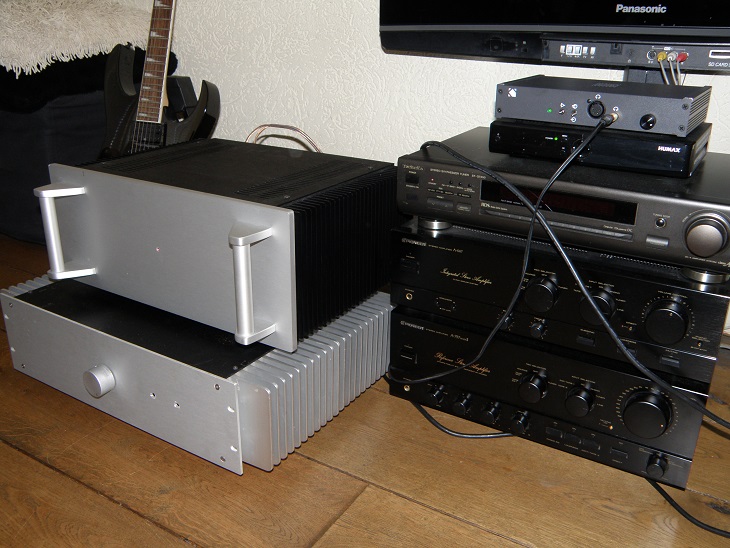
Notice the top left power amp
Attachments
Last edited:
Another little gathering...
Thanks koldby, I was quite happy to have you guys over! It seems that all those damping panels did work to make you forget the room, right?
What a fun filled weekend it was! We had a mini gathering of members koldby BYRTT and myself. a big thanks to both of you guys to take that long trip towards the lowlands .
.
On Friday night we started with an elaborate listening session, playing a wide variety of music. Between tracks we had plenty of room to talk.
As mentioned by koldby, he thought he was missing something, a whim of air on top I guess. I've always known my balance is on the dark side, a touch warm even, as I'm conditioned that way by my listening experiences in the past. But I had to agree. I've often tried a lighter balance up top, only to dial it down again over time. But things were about to change, little did I know .
.
We reserved the Saturday for a bit of testing...
Both of the gentlemen had brought some toys to this meeting! Lets see what we got:
BYRTT brought his Neurochrome HP-1 headphone amp and two of his headphones, the Status Audio OB-1 and the Senheiser HD 650. He also brought a laptop with on it JRiver and some FIR correction files for both.
I first listened to the OB-1 with correction applied. What a clear clean and open sound it had! A quick comparison to it's uncorrected behaviour was an eye opener. A world of difference. An open clear sound I certainly didn't expect from these.
Next up was the Senheiser, also with correction. Pleasing sound, more bass but to my surprise not nearly as open as the OB-1! They reminded me more of my German Maestro 8.35D in tonality. After hearing the OB-1 it just couldn't compete. I can honestly say I preferred the corrected OB-1 headphones over the much higher priced 650HD. I liked them that much that I went on Amazon to buy them: currently out of stock!
You can still get them at their own website, but I do remember the attractive pricing Amazon had on these, only a couple of months ago. Little did I know, I should have bought them right away!
Thanks koldby, I was quite happy to have you guys over! It seems that all those damping panels did work to make you forget the room, right?
What a fun filled weekend it was! We had a mini gathering of members koldby BYRTT and myself. a big thanks to both of you guys to take that long trip towards the lowlands
On Friday night we started with an elaborate listening session, playing a wide variety of music. Between tracks we had plenty of room to talk.
As mentioned by koldby, he thought he was missing something, a whim of air on top I guess. I've always known my balance is on the dark side, a touch warm even, as I'm conditioned that way by my listening experiences in the past. But I had to agree. I've often tried a lighter balance up top, only to dial it down again over time. But things were about to change, little did I know
We reserved the Saturday for a bit of testing...
Both of the gentlemen had brought some toys to this meeting! Lets see what we got:
BYRTT brought his Neurochrome HP-1 headphone amp and two of his headphones, the Status Audio OB-1 and the Senheiser HD 650. He also brought a laptop with on it JRiver and some FIR correction files for both.
I first listened to the OB-1 with correction applied. What a clear clean and open sound it had! A quick comparison to it's uncorrected behaviour was an eye opener. A world of difference. An open clear sound I certainly didn't expect from these.
Next up was the Senheiser, also with correction. Pleasing sound, more bass but to my surprise not nearly as open as the OB-1! They reminded me more of my German Maestro 8.35D in tonality. After hearing the OB-1 it just couldn't compete. I can honestly say I preferred the corrected OB-1 headphones over the much higher priced 650HD. I liked them that much that I went on Amazon to buy them: currently out of stock!
You can still get them at their own website, but I do remember the attractive pricing Amazon had on these, only a couple of months ago. Little did I know, I should have bought them right away!
One amp to rule them all...
On to the other toys, brought in by koldby, let's see a list first:
-Roender FC-100
-Fetzilla
-Goldmund Telos clone
-My Ref Fremen Edition
The quest for us was: do we hear differences between these amplifiers. And of course, is there one that stands out. As mentioned before, my amplifier of choice during this whole project has been the Pioneer A-757 Mark II. I've had this one ever since I bought it new somewhere back in 1991. It has been serviced a few times, weighs a ton and served me well. But I've always wondered: what if...
The first amp we listened to: a Roender FC-100
This amp definitely had more detail than the Pioneer by far. But not as engaging to listen to in a way. Can't put my finger on it exactly, but I'd still prefer the Pioneer.
Not overly bright or any other fault that jumps out, but not that captivating either. I guess I do like a more polite sound. Even if it's darker in its presentation.
Second in line: the Fetzilla
I wasn't prepared for this, I simply loved this one in the midrange. It breathed life into focal parts that wasn't there before.
Much preferred over the Roender, more captivating than the old Pioneer. It's the one that made my hairs stand up on a very familiar track. Even though it was underpowered compared to the Pioneer, I'd choose this one over my old and trusted reference, it was that good.
The third one up was a Goldmund Telos 350 clone
As soon as it started I remember uttering: I think I'm in love. Not much different sounding in the midrange than the Fetzilla but a seemingly endless bass capability. Not louder per see, just more authority. Sweet top end never the less, it seemed to really catch my attention. The total presentation of the music before us just worked! I'd pick this one over my old Pio reference any day!
Fourth in line: My Ref Fremen Edition
I had read about this one on DIYaudio, it's one of the names that has popped up more than once in my searches and it had my attention from all the rave reviews from people that build it.
Had to get used to the slightly different bass presentation, the mid had much in common with both amps before it, but it wasn't as captivating to listen to for me. Somehow I think the previous amp had spoiled me for everything that came next.
I started to lust for that bass I heard, just moments ago. This one seemed to do the midrange well, but somehow different... I just had to listen to the Goldmund clone again to compare the midrange.
Back to the Goldmund clone: Somehow this amp just fits in. It just works really well with the arrays as I have them set up. My preference by far from all the amps we listened to. It seemed to bring authority, very clear separation and on a couple of (for me) well known tracks the details were there with more definition. Imaging was improved compared to the old Pioneer, midrange did not disappoint when compared to the Fetzilla that shook me earlier.
We had to use a pré-amp for this test, BYRTT's HP-1 did double duty to accomplish that task. You can see it in the picture BYRTT posted before my (always too long ) ramblings. Setting them all to the same SPL level with my RadioShack SPL meter.
) ramblings. Setting them all to the same SPL level with my RadioShack SPL meter.
There you have it, a real subjective review of some amps after all that measured data in this thread . To complete the list, the Musical Fidelity M1 DAC was used to feed all these amplifiers, only the Pioneer used it's own build in pré-amp. The rest of them were routed trough the HP-1 (in my opinion a piece of art from tomchr).
. To complete the list, the Musical Fidelity M1 DAC was used to feed all these amplifiers, only the Pioneer used it's own build in pré-amp. The rest of them were routed trough the HP-1 (in my opinion a piece of art from tomchr).
There was a fifth amp available, a Hypex UcD, and even another DAC from which I don't recall the name. As it was a challenge to get that equipment to work with my setup we left those out of the equation.
Thanks guys for time well spend, and special thanks to my girl for her patience and care . I simply turn into a kid in a toy store and would forget all about basic needs like food and drinks
. I simply turn into a kid in a toy store and would forget all about basic needs like food and drinks  .
.
On to the other toys, brought in by koldby, let's see a list first:
-Roender FC-100
-Fetzilla
-Goldmund Telos clone
-My Ref Fremen Edition
The quest for us was: do we hear differences between these amplifiers. And of course, is there one that stands out. As mentioned before, my amplifier of choice during this whole project has been the Pioneer A-757 Mark II. I've had this one ever since I bought it new somewhere back in 1991. It has been serviced a few times, weighs a ton and served me well. But I've always wondered: what if...
The first amp we listened to: a Roender FC-100
This amp definitely had more detail than the Pioneer by far. But not as engaging to listen to in a way. Can't put my finger on it exactly, but I'd still prefer the Pioneer.
Not overly bright or any other fault that jumps out, but not that captivating either. I guess I do like a more polite sound. Even if it's darker in its presentation.
Second in line: the Fetzilla
I wasn't prepared for this, I simply loved this one in the midrange. It breathed life into focal parts that wasn't there before.
Much preferred over the Roender, more captivating than the old Pioneer. It's the one that made my hairs stand up on a very familiar track. Even though it was underpowered compared to the Pioneer, I'd choose this one over my old and trusted reference, it was that good.
The third one up was a Goldmund Telos 350 clone
As soon as it started I remember uttering: I think I'm in love. Not much different sounding in the midrange than the Fetzilla but a seemingly endless bass capability. Not louder per see, just more authority. Sweet top end never the less, it seemed to really catch my attention. The total presentation of the music before us just worked! I'd pick this one over my old Pio reference any day!
Fourth in line: My Ref Fremen Edition
I had read about this one on DIYaudio, it's one of the names that has popped up more than once in my searches and it had my attention from all the rave reviews from people that build it.
Had to get used to the slightly different bass presentation, the mid had much in common with both amps before it, but it wasn't as captivating to listen to for me. Somehow I think the previous amp had spoiled me for everything that came next.
I started to lust for that bass I heard, just moments ago. This one seemed to do the midrange well, but somehow different... I just had to listen to the Goldmund clone again to compare the midrange.
Back to the Goldmund clone: Somehow this amp just fits in. It just works really well with the arrays as I have them set up. My preference by far from all the amps we listened to. It seemed to bring authority, very clear separation and on a couple of (for me) well known tracks the details were there with more definition. Imaging was improved compared to the old Pioneer, midrange did not disappoint when compared to the Fetzilla that shook me earlier.
We had to use a pré-amp for this test, BYRTT's HP-1 did double duty to accomplish that task. You can see it in the picture BYRTT posted before my (always too long
There you have it, a real subjective review of some amps after all that measured data in this thread
There was a fifth amp available, a Hypex UcD, and even another DAC from which I don't recall the name. As it was a challenge to get that equipment to work with my setup we left those out of the equation.
Thanks guys for time well spend, and special thanks to my girl for her patience and care
 .
.
Last edited:
My pleasure...
Two more things worth mentioning: first, that big brutal beast of an amp gets to stay a little longer. Koldby let me borrow it for more long term listening. That's exactly what I will do! Need to see what I need as a Pré for it, my guess is that the pré amp part of the Pioneer won't be nearly as clean as that HP1. A real big thanks to koldby for this opportunity!
And second, it was a pleasure for me to try and convert BYRTT back to Stereo listening. I don't know if I succeeded at that part though .
.
I even played these gentlemen a couple of Madonna tracks, seriously!
First one was: "Ray of Light" and second one was "Frozen". Now I'm not a Madonna fan, not even close. But that first track was brought to my attention by a friend and it surprised me quite a bit for a seemingly simple POP track I had heard on the radio lots of times. I had not really heard it until I sat down and listened to it on the arrays. Marvellous production!
Two more things worth mentioning: first, that big brutal beast of an amp gets to stay a little longer. Koldby let me borrow it for more long term listening. That's exactly what I will do! Need to see what I need as a Pré for it, my guess is that the pré amp part of the Pioneer won't be nearly as clean as that HP1. A real big thanks to koldby for this opportunity!
And second, it was a pleasure for me to try and convert BYRTT back to Stereo listening. I don't know if I succeeded at that part though
I even played these gentlemen a couple of Madonna tracks, seriously!
First one was: "Ray of Light" and second one was "Frozen". Now I'm not a Madonna fan, not even close. But that first track was brought to my attention by a friend and it surprised me quite a bit for a seemingly simple POP track I had heard on the radio lots of times. I had not really heard it until I sat down and listened to it on the arrays. Marvellous production!
Last edited:
Let me add , that I agree , word for word, with what wesayso is describing above, including the headphones (I was lucky enough to grab a set at the cheap price) and the headphone amp BRYTT brought along. And even the Madonna tracks (much to my surprise).
Thanks for a great time both of you..
Thanks for a great time both of you..
...And second, it was a pleasure for me to try and convert BYRTT back to Stereo listening. I don't know if I succeeded at that part though...
Admit hate a little bit to change my own experience and conclusions in the middle of the road but like your excellent system showed (thanks) then also those new head phone gear support i shall accept the convert back to stereo, so as soon my new whatever mono build beat the old one i know what to do
...I even played these gentlemen a couple of Madonna tracks, seriously!
First one was: "Ray of Light" and second one was "Frozen". Now I'm not a Madonna fan, not even close. But that first track was brought to my attention by a friend and it surprised me quite a bit for a seemingly simple POP track I had heard on the radio lots of times. I had not really heard it until I sat down and listened to it on the arrays. Marvellous production!
Yes a big surprise but what a quality sound and recording we heard there.
Let me add , that I agree , word for word, with what wesayso is describing above, including the headphones (I was lucky enough to grab a set at the cheap price) and the headphone amp BRYTT brought along...
+1
About the slightly changed new correction for OB-1 head phones have it at present only as 64bit convolution files so in coming days will create them also as 32bit and share via pm.
A note also for wesayso should he get a pair of those OB-1 is that expect even a bit better sound that you heard because the soundcard DAC was not on par with what myself and you two have in our main systems at home.
I even played these gentlemen a couple of Madonna tracks, seriously!
First one was: "Ray of Light" and second one was "Frozen". Now I'm not a Madonna fan, not even close. But that first track was brought to my attention by a friend and it surprised me quite a bit for a seemingly simple POP track I had heard on the radio lots of times. I had not really heard it until I sat down and listened to it on the arrays. Marvellous production!
Try " Drowned World/Substitute For Love" from the same album. The bass line should shine on your system.
Sounds like a fun time at Wesayso’s. Reminiscent of a little over a year ago when I was there with Byrtt and experienced the Towers. Sounds like the Goldmund Telos 350 is an amp that I will have to check out. The Fetzilla uses lateral MOSFETs, which won’t have as good bass authority as hexFETs. But you did experience the mid range that Aksa’s amps are famous for. Thanks for sharing.
Try " Drowned World/Substitute For Love" from the same album. The bass line should shine on your system.
+1
This is actually not so. The Goldmund uses the same output devices as the Fetzilla.Sounds like a fun time at Wesayso’s. Reminiscent of a little over a year ago when I was there with Byrtt and experienced the Towers. Sounds like the Goldmund Telos 350 is an amp that I will have to check out. The Fetzilla uses lateral MOSFETs, which won’t have as good bass authority as hexFETs. But you did experience the mid range that Aksa’s amps are famous for. Thanks for sharing.
Sounds like a fun time at Wesayso’s. Reminiscent of a little over a year ago when I was there with Byrtt and experienced the Towers. Sounds like the Goldmund Telos 350 is an amp that I will have to check out. The Fetzilla uses lateral MOSFETs, which won’t have as good bass authority as hexFETs. But you did experience the mid range that Aksa’s amps are famous for. Thanks for sharing.
Do check out their design philosophy... from what I read they put a very big emphasis on time coherency... I only discovered that part after listening to it first.
A big recommendation from me for their efforts. It seems to pay off!
- Home
- Loudspeakers
- Full Range
- The making of: The Two Towers (a 25 driver Full Range line array)
